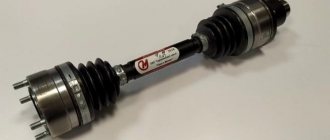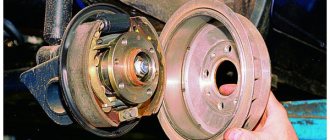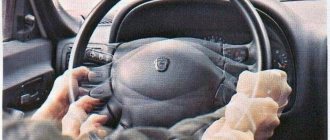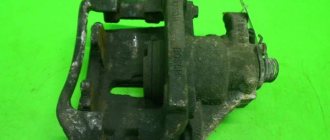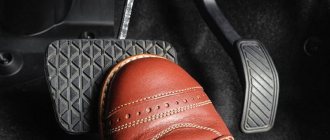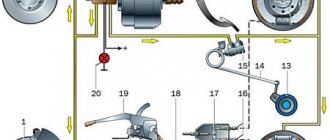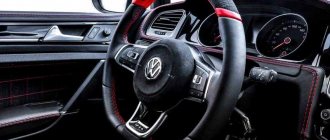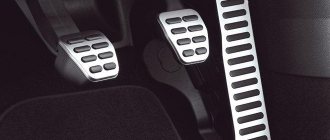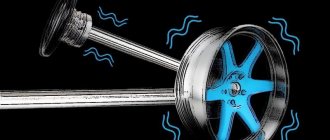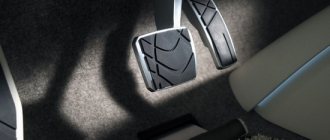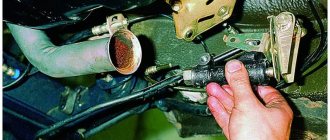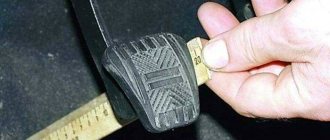When the brake system is working properly, the car stops smoothly, the driver feels the responsiveness of the pedal when it is pressed. The stopping trajectory is straight, without a roll to the left or right. When the brake pedal hits during smooth braking, this indicates a malfunction. The methodology for finding causes depends on the behavior of the machine. It must be said right away that with timely maintenance and compliance with the regulations, this problem should not exist. But there are also exceptions.
Direct reasons
When you feel beating when you press the brake pedal, then it is necessary to carry out an urgent and complete diagnosis.
To do this, you should contact a high-quality car service center, where qualified specialists work. However, you can identify the reasons why the pedal hits when braking on your own. This method is suitable for experienced car enthusiasts.
Brake discs
Among the most common and popular reasons are broken and damaged disks. They, in turn, can fail due to various damages or deformations.
Disks break due to critical temperature changes. When braking, the element instantly heats up and then cools down just as sharply. It is because of these temperature jumps that various curvatures occur. If the brake pedal hits when braking, then you should carefully check the elements for damage, cracks, or deformations. If even the slightest defect is detected, the damaged part should be urgently replaced. To check where exactly the defective disk is installed, use the handbrake. If there is no vibration in this case, then the culprit is at the front.
Also, sometimes vibrations can appear due to corrosion, but wear on the working surface may be normal. In this case, it is recommended to sharpen the discs. This should be done by an experienced turner. However, there are technologies for grooving directly on the machine, without removing the discs. This procedure is much cheaper. You also need to make sure that the disks are mounted correctly. If poorly installed on the mating surface, braking will be accompanied by a runout effect.
How to determine wear of the chassis and other breakdowns?
Is the failure at the front, but the tested discs are in perfect condition? A visual inspection of the chassis system allows you to find a breakdown. Tie rods and ends are likely causes of steering wheel wobble.
It will be difficult for an inexperienced person to notice the deformation of the structure. But if you notice unnatural bends, then the reason for the vibrations becomes clear. In less severe cases, it is necessary to rely on inspection and evaluation of the system as a whole.
A herniated or deformed tire is easily detected visually even by an inexperienced driver. There shouldn't be any problems with this. If there is no visible damage, it will be useful to remove the wheel and examine the surface from the inside.
Pads
Among the malfunctions of the brake system in a car there may be pads.
This problem is very easy to “cure”. A simple replacement is enough and the beating will stop. The brake pedal often hits when braking due to the so-called “sticking” rear pads. If you press the pedal too often and sharply when driving at high speed, then inexpensive elements may become painted. In this mode they wear out quickly. The solution is simple - replacement.
Is it possible to ignore the problem?
The braking system is one of the most important, since driving safety and the efficiency of stopping a vehicle directly depend on it. Any disruption to operation is extremely undesirable and it is not recommended to travel with them.
Some drivers ignore vibration, which later leads to more serious problems or even accidents as braking performance is reduced. And if this is not important under normal conditions, it is greatly manifested in an emergency situation.
If it is noticed that the operation of the system is disrupted, first of all make sure that everything is in order with the parts, there is no visible damage or leakage of brake fluid. After which you can continue driving, but it is advisable not to postpone your visit to the auto repair shop. If braking efficiency has decreased, it is better not to take risks, but to immediately begin repairs or contact a service center.
By the way!
When driving an automatic transmission, if vibration appears when the brake is pressed in the “D” gearbox position, first check the automatic transmission support cushions. If everything is in order with them, then the vibration sensor is diagnosed.
Rear drum
This is the fourth reason why the pedal cannot operate normally.
This happens more often on GAZelles. There the rear brake drum is deformed, and therefore the brake pedal hits when braking. The GAZelle is equipped with a drum brake at the rear. If it is in a neglected state, then it is natural that vibrations appear.
Summarizing
The vibration of the brake pedal when braking is one of the symptoms of a malfunctioning brake system. The consequences can be very different from simple wear of parts to the creation of emergency situations due to brake failure.
For full operation of the brake system, full contact between the surface of the friction lining of the pad and the brake disc is necessary. If replacing worn parts helped only temporarily, maybe you should think about changing your driving style, because it is your driving style that affects the service life of the parts.
You should also not allow the temperature of heated elements (discs and calipers) to change; try to avoid puddles after braking, and also allow the brakes to cool before washing the car. To avoid breakdowns, you should visit service stations more often to check the performance and preventive maintenance of brake mechanisms, repair them in a timely manner, and also periodically inspect your brakes yourself.
You can test and find any faults in the brake system in your car on an empty section of the road, away from houses and pedestrians in order to avoid accidents.
First of all, you should carefully monitor the car’s braking process, listen to see if there are any extraneous noises or squeaks, whether the braking is uniform, or whether the direction of movement changes during sudden braking.
Indirect faults
If, after checking typical and popular faults, the brake pedal still hits when braking, then problems should be looked for in other, most unexpected places. Other problems that can cause vibration or beating include wheel bearings that are heavily worn during operation. Replacing them can correct the situation. In addition, due to use, the levers on the front wheels wear out.
Vibrations can also occur as a result of unbalanced wheels.
In this case, the pedal hits hard, but the main knocks are still heard on the body. Solving this issue is not difficult - in the simplest case, balancing will help. In the worst case, the wheels will have to be replaced.
If you have checked everything, but still cannot figure out why the pedal hits when braking, then you should check the tightness of the nuts, bolts and other fasteners. Insufficiently tightened fasteners may be the cause of backlash. At high speeds this can cause significant runout, and in such cases the brakes are usually checked.
The grinding noise constantly intensifies and is quite sharp.
One of the most common situations in which you will need to use the help of specialists at a service station is an increase in grinding or a sharp, strong sound of metal rubbing against metal. Most likely, the block is completely worn out; you continue to brake with the sole of the block, which is made of hard metal. If this problem is not addressed promptly, the brake disc may fail and require replacement. In this case, repairs will be three times more expensive, so it is better to immediately identify all possible malfunctions and problems that caused the grinding noise when braking. In particular, to diagnose this problem, it is enough to carry out the following processes:
- determine from which side the grinding sound is heard, this will help you halve the amount of work required for diagnosis;
- remove the wheel that you suspect is making unpleasant sounds when braking;
- examine the exposed brake disc for grooves, chips and other problems with the working surface;
- look at the remaining layer of the brake pads, determine the degree of wear and the need for replacement;
- also examine the second wheel on this side, and best of all, examine the braking system on all wheels;
- Identify possible problems that could lead to squeaking and consult with specialists.
This will often help you determine the cause of the squealing noise when braking for free, but disassembling the brake system and performing repair work yourself is not always wise. You can use the services of specialists and guarantee the normal operation of the brake system. However, it is quite possible that all braking systems visually appear to be in good working order, but the grinding noise is still present. Then see if the car's behavior has changed during braking. If there are changes, you will have to pay more attention to this problem. If there are no changes, you can continue to operate the car until the grinding noise intensifies and gives specific clues.
When braking, the brake pedal and steering wheel hit
Sometimes vibrations in the steering wheel are added to the beats on the brake pedal. There are many reasons for this effect. This includes imbalance, worn brake pads, steering rods, and cardan drives.
Even if the wheels seem to be perfectly balanced, this is not a guarantee that everything is really good. To find out if this is so, a special stand is needed. It is recommended to carry out balancing for all wheels at once.
A common problem with domestic and foreign cars is wear of the front pads. Because of this, the steering wheel shakes. To carry out diagnostics, the car is placed in a pit and the discs and pads are inspected. If there is serious wear, then only replacement, if the wear is minor, then you need to look for the real reason. Often when braking, the brake pedal hits (VAZ-2110 is no exception), as well as the steering wheel. Experienced car owners recommend checking the rear pads and the entire system, if vibrations are felt on the pedal, and if on the steering wheel, then look at the brakes from the front.
Diagnostics
Checking brake discs with a micrometer;
So, we have looked at the probable causes of the brake pedal beating. How can we determine which of them played a negative role in this particular machine? This requires a comprehensive and thorough diagnosis. And it is best if the research is carried out in a specialized car service center.
As part of diagnostic activities, the following work is performed:
- checking the geometry of discs and drums;
- checking the pads;
- testing of wheel bearings;
- inspection of suspension fasteners.
The geometry of discs and drums is checked on a special stand, which accurately records the curvature of the flat pressure pad of the disc and the ellipticity of the inner surface of the drum. To determine the degree of pad wear, use a caliper or micrometer. The condition of the wheel bearings is determined using special equipment that determines the amount of camber and toe-in of the rotating wheels from the normal position.
Ball joints
Experienced car enthusiasts recommend carefully checking the entire chassis.
The reason could be hidden anywhere. Thus, there are frequent cases when the brake pedal hits when braking (VAZ-2114 is no exception) due to a faulty or worn ball joint. This is the first thing to check.
For inspection, the car is jacked up, and the ball joint is installed so that the wheel hangs in the air. Then, with the palm of one hand, take the wheel by the upper part, and with the other hand, by the lower part. You need to wobble the wheel with your hands. If the wobble is present and felt, then the ball joint must be replaced. This should eliminate vibrations and knocking.
Human factor
This point also cannot be excluded. Sometimes this happens, and the situations are very different.
If, when replacing a wheel, you (or the mechanics) were in a hurry to finish the job, you might not have fully tightened the mounting bolts. Such inattention can lead not only to vibrations and beating on the pedals. This is how you can lose a wheel. As you can see, there are many reasons. They are all different. They all produce the same effect. You should carefully monitor the condition of the car and, if necessary, replace worn parts and components in a timely manner. It is also worth listening to the recommendations of car manufacturers.
So, we found out why the brake pedal hits when braking.
How to avoid car brakes from squealing
If the brake pedal begins to vibrate when pressed, then this problem will not go away on its own. It is necessary to diagnose the machine as soon as possible and eliminate the malfunction. To avoid such troubles in the future, you need to follow these recommendations:
- Monitor the brake fluid level in the reservoir;
- Regularly check the brake system for leaks;
- Change the pads on time, without waiting for their maximum wear.
The braking system is nothing to joke about, and at the first symptoms of its malfunction, the problem should be eliminated.
Welcome, friends, to the DIY car repair website. Driving a car is always a certain risk, the level of which depends on the serviceability and correct functioning of the main systems. In this case, the most important component remains the brakes.
Brake pedal squeaks when braking
The efficiency of their work determines overall traffic safety. If the brake pedal hits when braking, this cannot be ignored. The consequence of such a breakdown may be partial or complete failure of the system.
